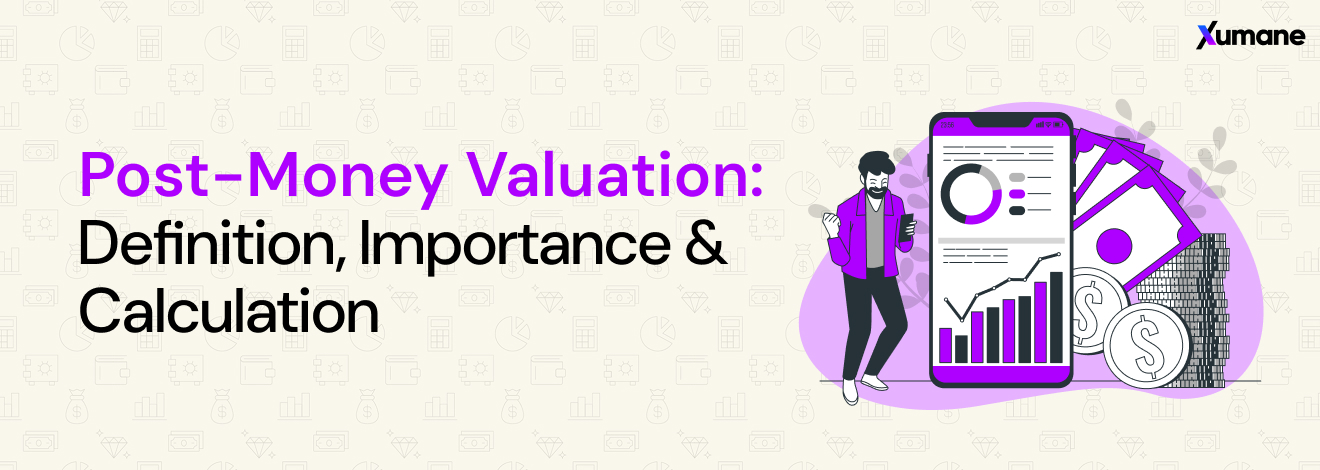
Subscribe to stay ahead with expert insights on ESOPs, smart ownership strategies, and more!
Editor's Note:-In this blog, we will delve into what post-money valuation is. We have simplified and delved deeper into its importance, calculation, and how it impacts equity and fundraising decisions.
Are you an HR/finance professional looking to understand post-money valuation? Perhaps a founder looking for answers about conducting it within their company?
Whether you're an entrepreneur or part of the organization, understanding the term will give you the best idea about your company’s worth after external investments. This metric will help you understand your company’s growth potential and make strategic decisions.
We know that understanding the concept and calculating the valuation formula can be a daunting task.
But don’t worry, we’ll break it down in the simplest way possible.
Let’s get started.
It is the worth of a startup after an investment round wherein funding is received by an angel investor, a venture capitalist , or any other investor.
It is derived once the pre-money valuation is done i.e. the valuation of the company previous to fresh funding is calculated.
Speaking of valuation, it is a tentative or hypothetical concept. Founders and existing investors want the valuation to be high because this will imply that the startup's idea, service, or product is promising. On the other hand, any new investor will want a comprehensive assessment of the startup's performance and capabilities before they invest their money into it.
A high post-money valuation showcases investor confidence and positions your company for further success, while a lower valuation can provide valuable insights for course correction.
Coming back to its definition, simply put, it is the value of the pre-money valuation plus the additional amount invested by new investors.
But, But, why is the valuation after the investment important?
Let’s see why.
Not understanding why the valuation is important and jumping the gun and conducting one for your company is like driving without a map.
You will neither understand what the numbers denote nor know where the loopholes lie.
Here is why the valuation post-funding round is important for an organization:
Tip! Maintain a cap table management software to simplify data analysis pre and post-valuation.
Using software will offload a lot of your routine work that requires you to edit numbers for different investors and ESOP holders. It also gives you an overview of outstanding shares, diluted shares, the amount raised, and the valuation. This enables you to get a quick glance at your existing share allocation and values in real time.

You must be wondering how to calculate post-money valuation. We’ll delve into it next.
Let’s keep this straightforward.
Calculating post-money valuation can be done in two ways:
You can apply either of the post-money valuation formulas and calculate the valuation effectively.
For example, let’s take the first method to calculate it.
Suppose a company was valued at $50 million. An investor decides to fund it with $10 million.
Here, the post-money valuation would be:
Pre-money valuation + Fresh funding → $50 million + $10 million → $60 million.
Next, let’s understand how post-money valuation and equity ownership work with the help of an example.

Assume a company has a pre-money valuation of $10 million. An angel investor invests $2 million into the company. The valuation after the investment after this funding injection, will be $12 million.
In such a scenario, the investor would secure a 16.6% equity in the organization.
How? Let's quickly do the math.
% of Equity = Amount Invested ÷ Post-Money Valuation
= $2 million ÷ 12 million
= 16.6%
So, for the above example, the equity of the new investor would be 16.6%.
Knowing the accurate equity ownership is important both for the new investor and the existing shareholders.
For the existing shareholders, the accurate equity figure ensures transparency regarding their stake in the company.
And, for new shareholders, this figure provides insight into the company's growth and current capital structure.
Not being well informed about post-money valuation before conducting it is nothing short of flying blind. And this can get in the way of high-impact company decisions.
The valuation can have company-wide impacts on performance and budgets.
Managing valuation, cap tables, and individual ESOPs of employees can be tricky.
If you’re tired of updating your financial data in spreadsheets and emails and are ready for a streamlined visualization of your company’s valuation, a cloud-based equity and cap table management platform is all you need to visualize key financials and make informed decisions for your company.
All the best!
It is the worth of a company after receiving external investment. It is calculated by adding the pre-money valuation and the new investment amount.
It is important for startups as it impacts the equity dilution and alters the ownership structure. This valuation forms the base for future fundraising rounds as it highlights investor confidence and market perception of the startup's growth potential.
The valuation directly impacts the percentages of the existing investors while obviously influencing the equity of new investors. It is calculated as the total investment amount divided by the valuation after money is raised.
Apart from the investment amount, the valuation is influenced by the company's growth potential, market perception, financial performance and the competitive ecosystem.